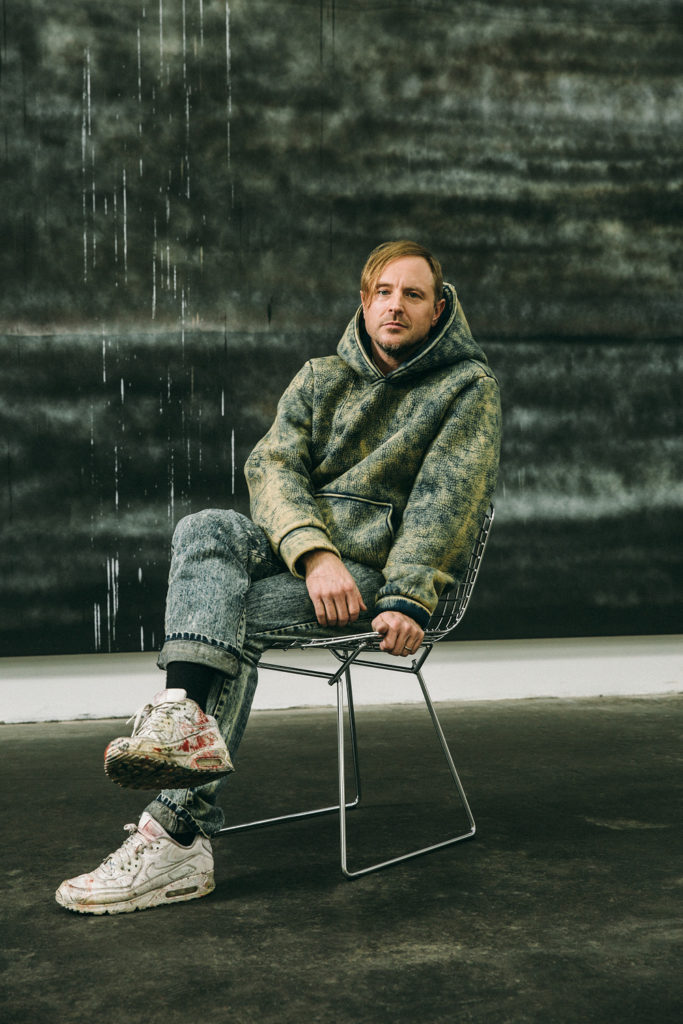Art
Stretching the Canvas
Sterling Ruby combines art and fashion with his close friend Raf Simons.
By Kevin McGarry
Photos by G L Askew II
February 13, 2017
Sterling Ruby combines art and fashion with his close friend Raf Simons.
By Kevin McGarry
Photos by G L Askew II
February 13, 2017
Sterling Ruby has a star’s name. It evokes a gothic opulence, calling to mind a cursed dagger, perhaps, or a vampire’s jewelry. That sense of fantasy provides an apt portal for entering Ruby’s world. He styles himself in self-made uniforms chemically mangled to the extent that he looks a little like an extra from Mad Max. One meme that circulated among young artists on Instagram about a year ago paired him, in his then-signature bandana, with his burlier doppelgänger, David Foster Wallace. There is surely an element of an aching poet to Ruby’s persona, one that mixes with his abiding earnestness to form a counterpoint to the fact that his studio practice has grown to be among the largest and more lucrative enterprises in contemporary art today.
Ruby’s first Chelsea solo exhibition at Foxy Production, in 2004, and two mid-aughts shows at the Los Angeles gallery Marc Foxx led to a meteoric rise. Since then, he has developed into a renaissance man for the end of the world: with an apocalyptic palette, his prodigious, often sinister-looking output has spanned far beyond art objects, traversing into fashion and interior design. “Nowadays,” he says, tugging on his monastic, acid-washed hoodie, “I only wear what I make. Except for my pair of studio Nikes.” A bit later, he tells me, “At one point, I realized I should cannibalize my work and wear it.”

Sterling Ruby with Raf Simons. (Photo: Weston Wells for Surface magazine)
…
In addition to collages, paintings, ceramics, videos, sculptures, and drawings, Ruby, 45, has been making his own clothes for almost a decade. It was by chance that, around the same number of years ago, he forged a relationship with the Belgian fashion designer Raf Simons, 49, who first approached him as a curious art collector on the suggestion of a friend. “I saw a couple of his ceramics at art fairs, and I kept thinking, Who is that? Sometimes you see work and it just stays in your brain,” Simons says. “They were the realest thing I had seen in a long time, and they fascinated me.”
Flash forward to 2017. One of the most closely guarded, if much rumored, secrets concerning Simons’s overhaul and relaunch of the American fashion brand Calvin Klein, where he is chief creative officer, was the role Ruby would play in it. This turned out to be a bigger one than most expected, but it’s been a long road from the pair’s initial interest in one another to get here.
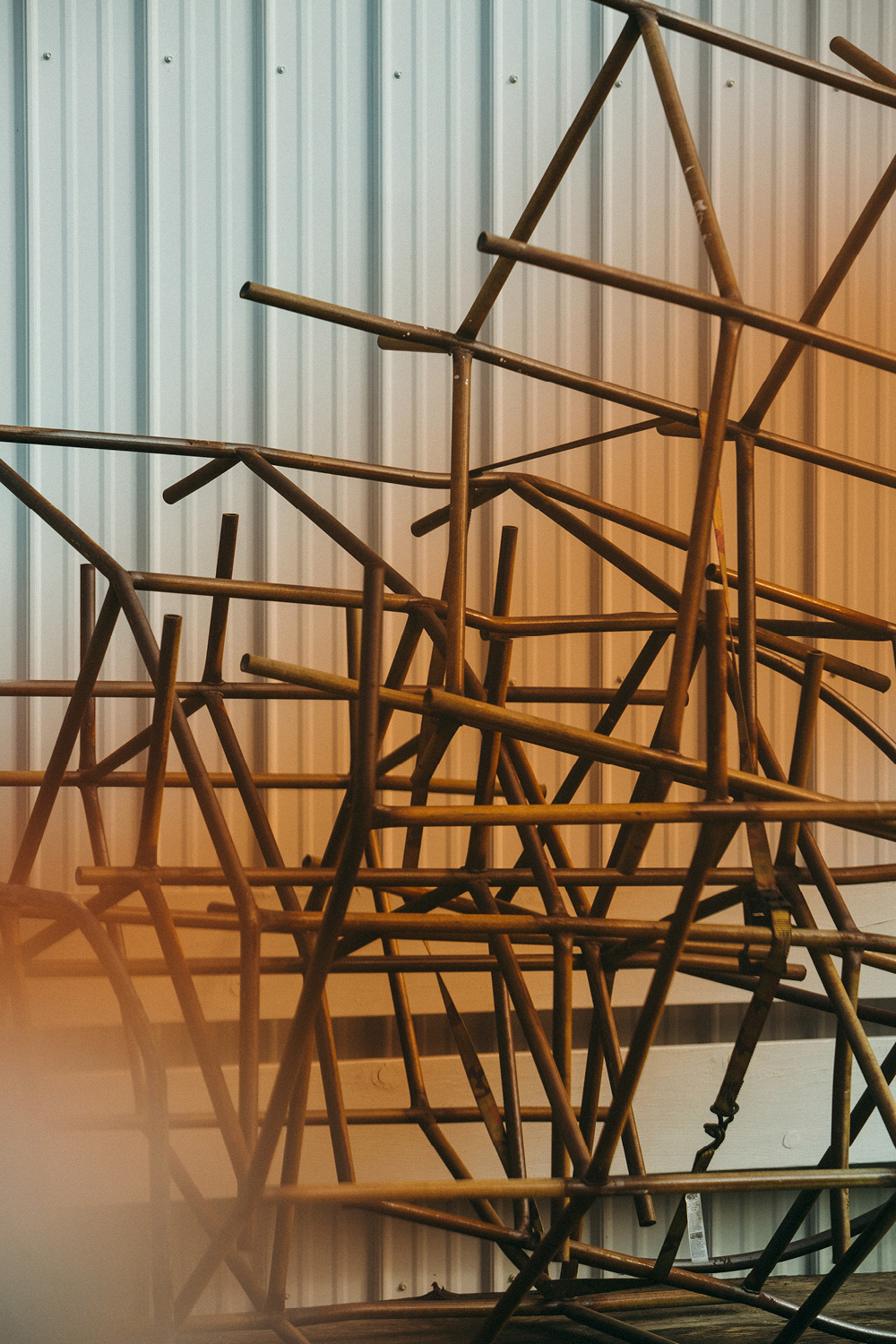
An artwork in Ruby’s studio.
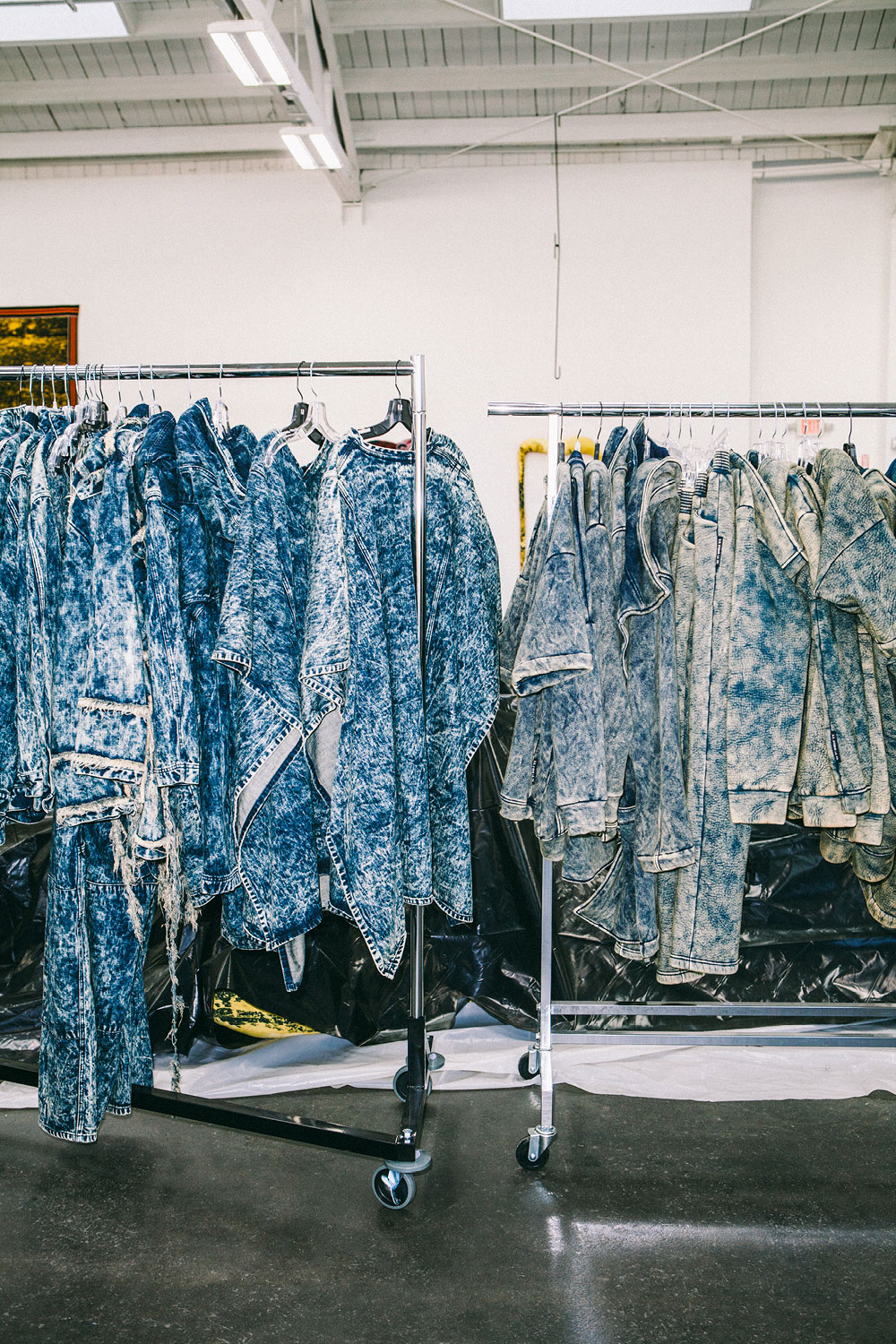
Racks of Ruby-designed clothing.
…
Shortly after meeting, as Ruby and Simons’s respective profiles rose, they became friends. In 2008, Ruby designed the interior of the Raf Simons Tokyo store, and a year later Simons used denim bleached by Ruby to create a collection of jeans and jackets. For three dresses and a coat in Simons’s first Dior couture show in 2012, he made signature fabrics—prints mixing black streaks with gray haze, lit by the atomic dawns of acrid pinks and greens—from photographs of paintings by Ruby. In 2014, the pair took their creative marriage to the next level with the Raf Simons Sterling Ruby collection, which consisted of pieces such as jackets inspired by Ruby’s Mexican blanket meets Russian Suprematism collages; red, white, and blue knits of the exact hues used in the artist’s “soft sculptures” of menacing snake fangs skinned with American flags and dripping cartoonish droplets of blood; and monochrome outfits splattered with bleach, reminiscent not only of works around the studio but of what Ruby wears while making them.
Over the past decade, general diplomatic relations between the worlds of art and fashion have become increasingly close, stoked by a common interest in the luxury consumer. Ruby’s and Simons’s pioneering experiments of putting art into fashion became, well, fashionable; brands now frequently adapt imagery made by contemporary artists into material for their collections. The just-unveiled Calvin Klein project, however, represents a more complex investment, in a way placing fashion inside art, not just the other way around.
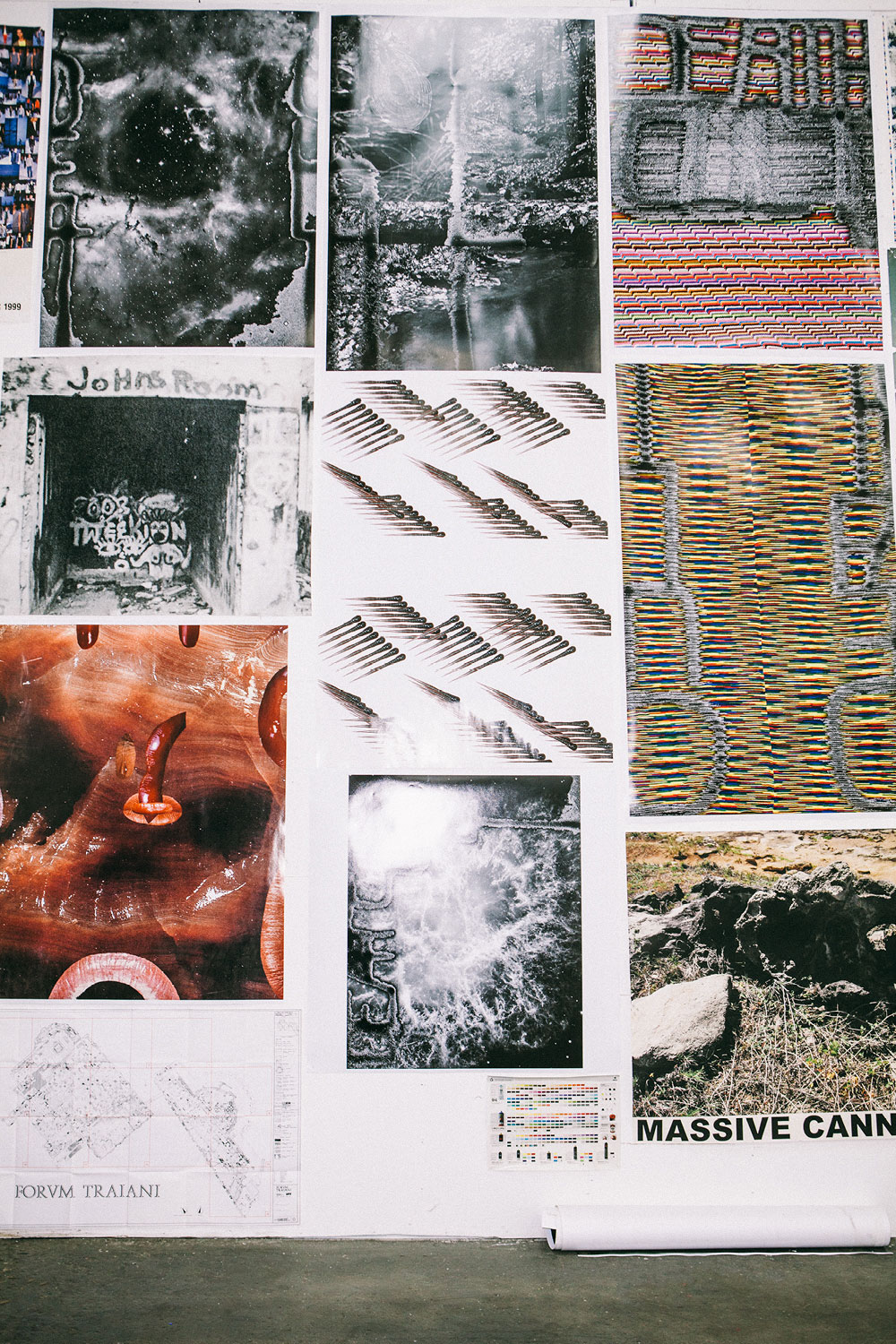
Work in Ruby’s studio.
…

An artwork in Ruby’s studio.
…
“Coming to Calvin Klein,” Simons says, “I found it important we make clear to the audience that we are talking about an American brand that has been based in New York City, in this building, for many years,” referring to the company’s corporate headquarters near Times Square. “I want to attract the attention to the house again.” Citing the importance that Parisian brands like Chanel and Dior put on the lore of their maisons, he continues, “I had the feeling that Calvin became more and more fragmented. We’re putting these ingredients back together: New York City. America. Calvin Klein. Sterling and I have a lot in common when it comes to thinking about clothes, space, environment, and attitude, so I thought it could be amazing to work with him on different spaces that redefine how I see the company evolving.”
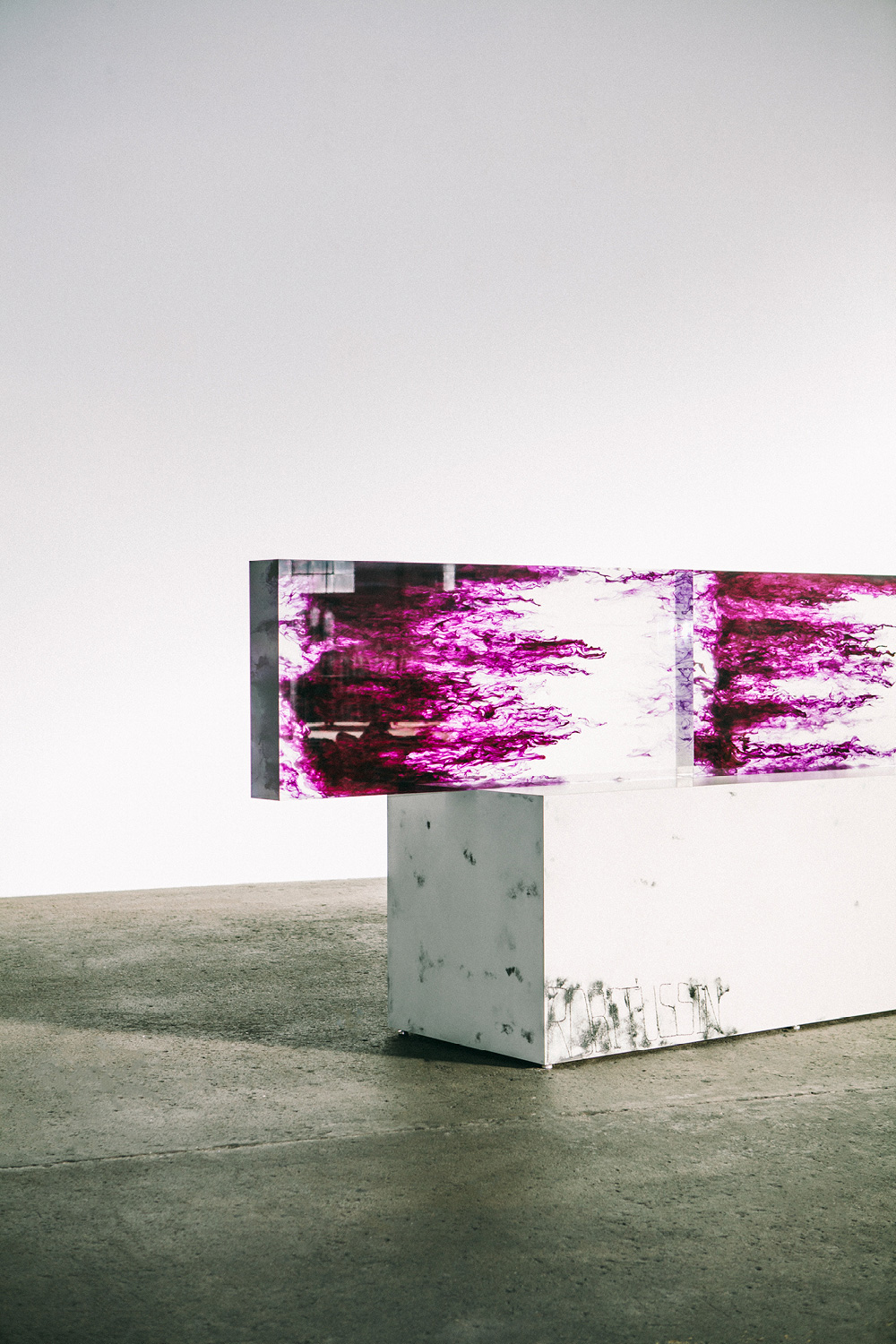
An artwork in Ruby’s studio.
…
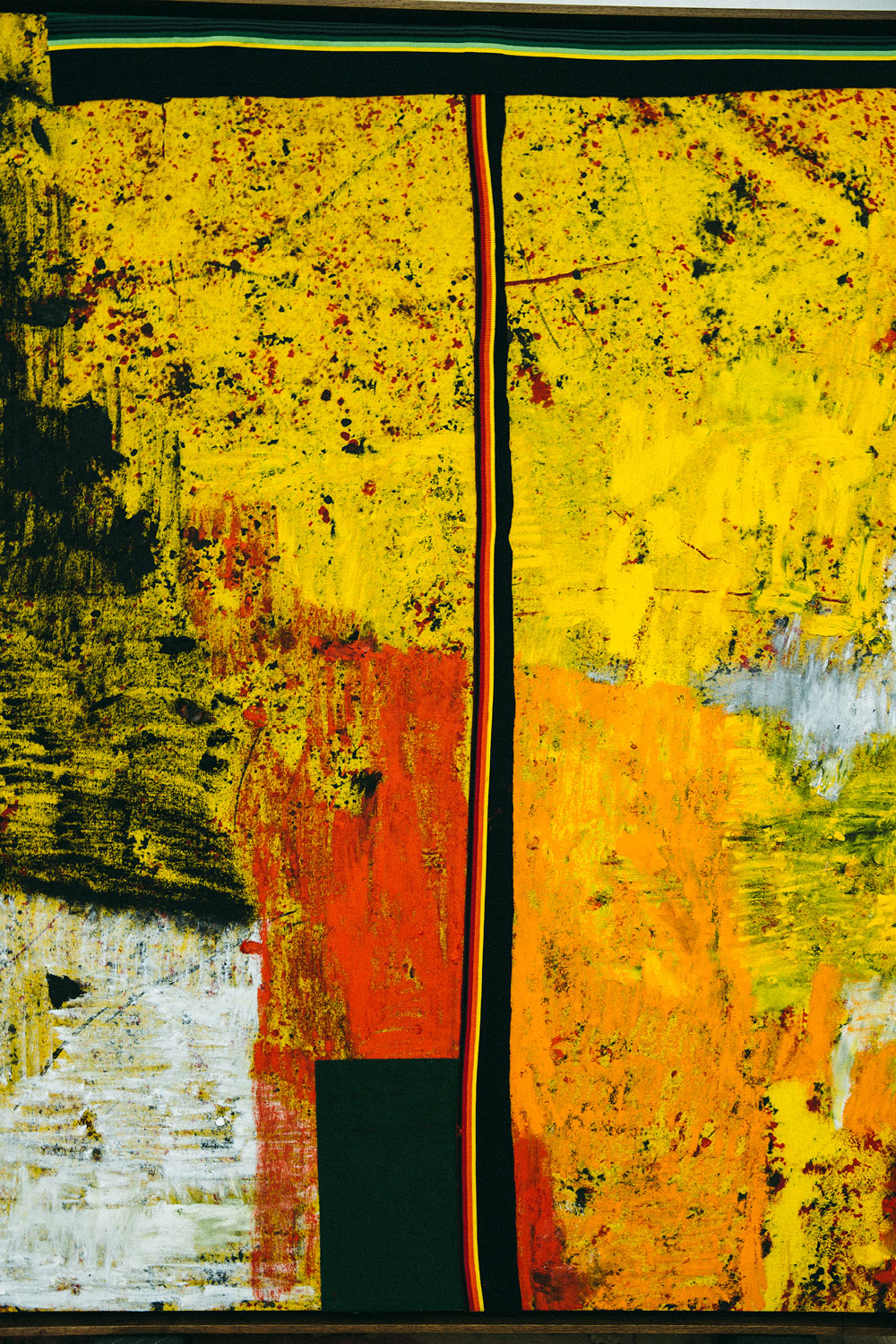
An artwork in Ruby’s studio.
…
Ruby describes the conceptual components of their undertaking this way: “I think it’s a vision of youth, of reconfiguring American fashion but also American corporate art and corporate culture—and, in a way, sex.”
With that in mind, the artist has applied a sculptural logic to the strikingly spare redesign of two spaces at the Calvin Klein headquarters whose functions are to merchandise clothes, and more abstractly, to express the brand itself. The first of them is the ground floor “Lookspace,” where Simons’s debut Calvin Klein Collection runway show took place February 10. The open, eight-columned room, which has windows that look out onto the street, was dominated by a massive hanging mobile, much like the one in the artist’s recent exhibition at Sprüth Magers gallery in Berlin. The second space is a showroom on the 12th floor of the same building, for private sales and wholesale buyers: “It’s a collage-oriented mix of hand-painted walls, poured concrete floors, pedestals and risers, fabricated tables, and one component I brought in as a historical nod to America: Bertoia chairs,” he says. “This is essentially Raf’s and my version of what this big American fashion house should look like now.”
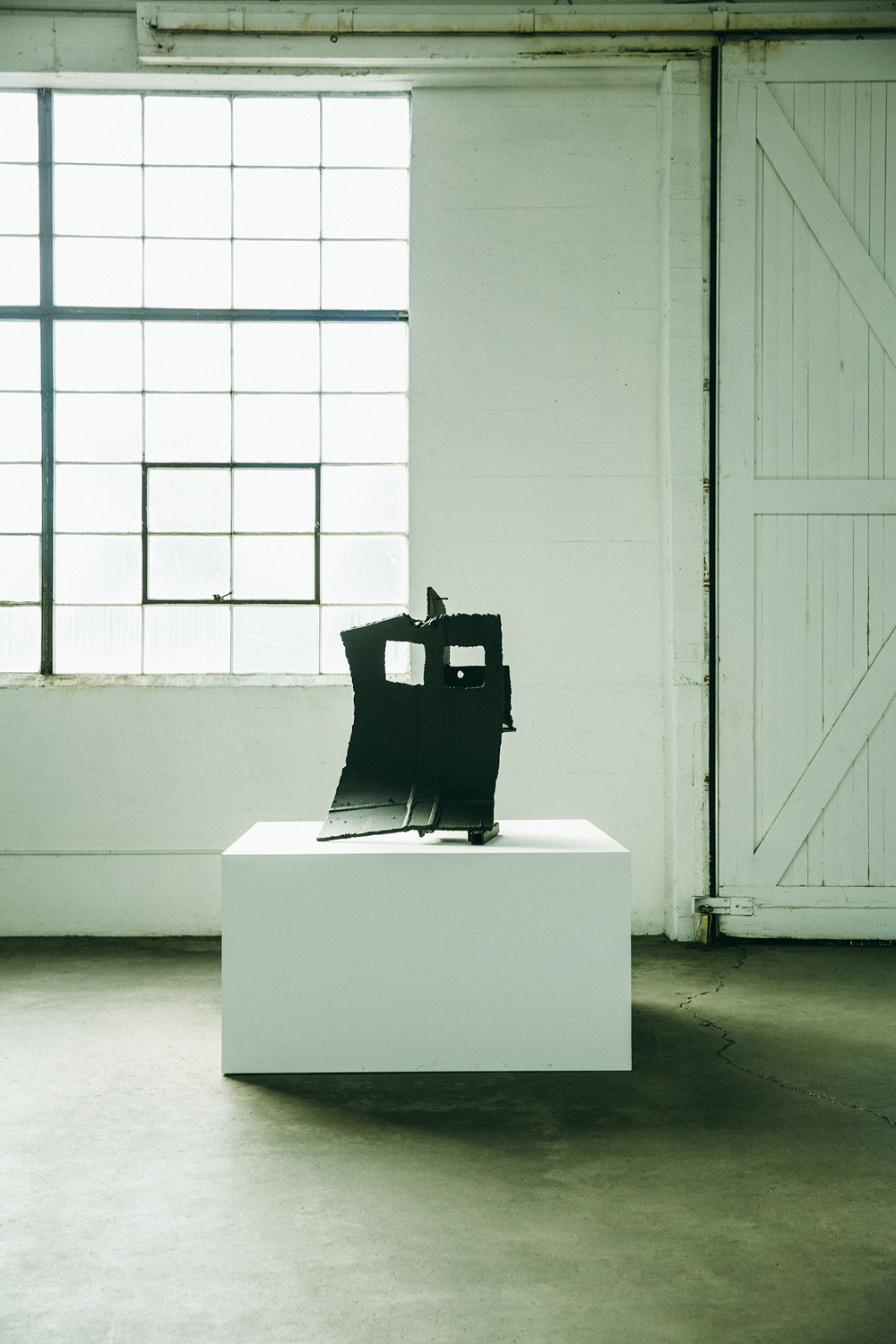
An artwork in Ruby’s studio.
…
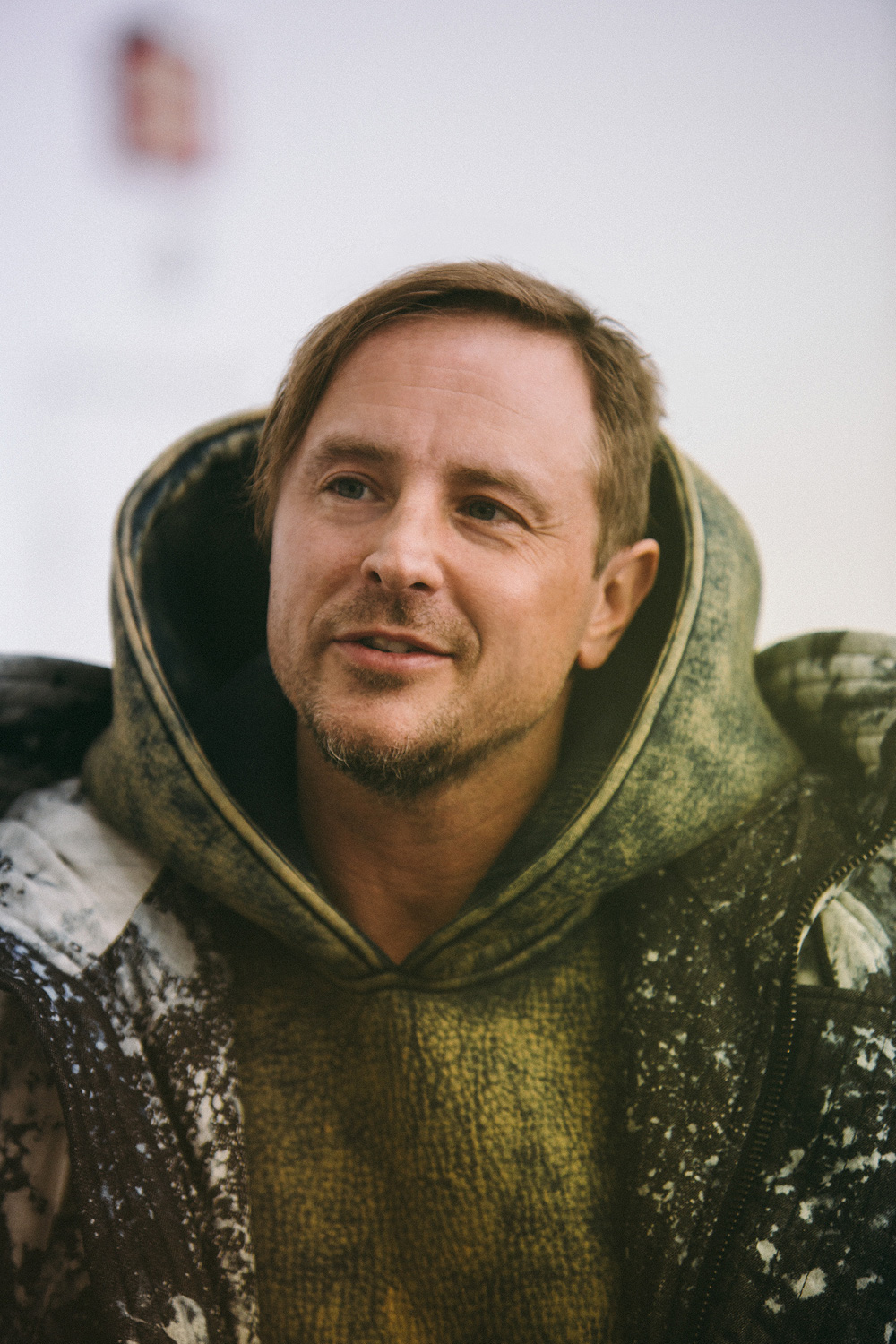
The artist in his studio.
…
Ruby and Simons are also collaborating on the forthcoming summer 2017 renovation of the company’s flagship store on Madison Avenue (originally designed by John Pawson). Simons says, “It’s very much about the juxtaposition of the collection, which is what I do, with the space where it is presented and sold, which is what Sterling is doing.”
A few days before Christmas, I was on my way to meet Ruby at his studio in Vernon, California, a rather desolate industrial area south of Downtown Los Angeles that’s home to manufacturing plants, corporate campuses, and, by his estimation, fewer than 200 residents. “Vernon probably has a smaller population than New Freedom, Pennsylvania, where I grew up,” he jokes after I proposed the comparison, fascinated by how after his rural upbringing in a south central Pennsylvania town he eventually made his base in what feels like a dystopian homestead in the rusty bowels of the West Coast’s largest city.
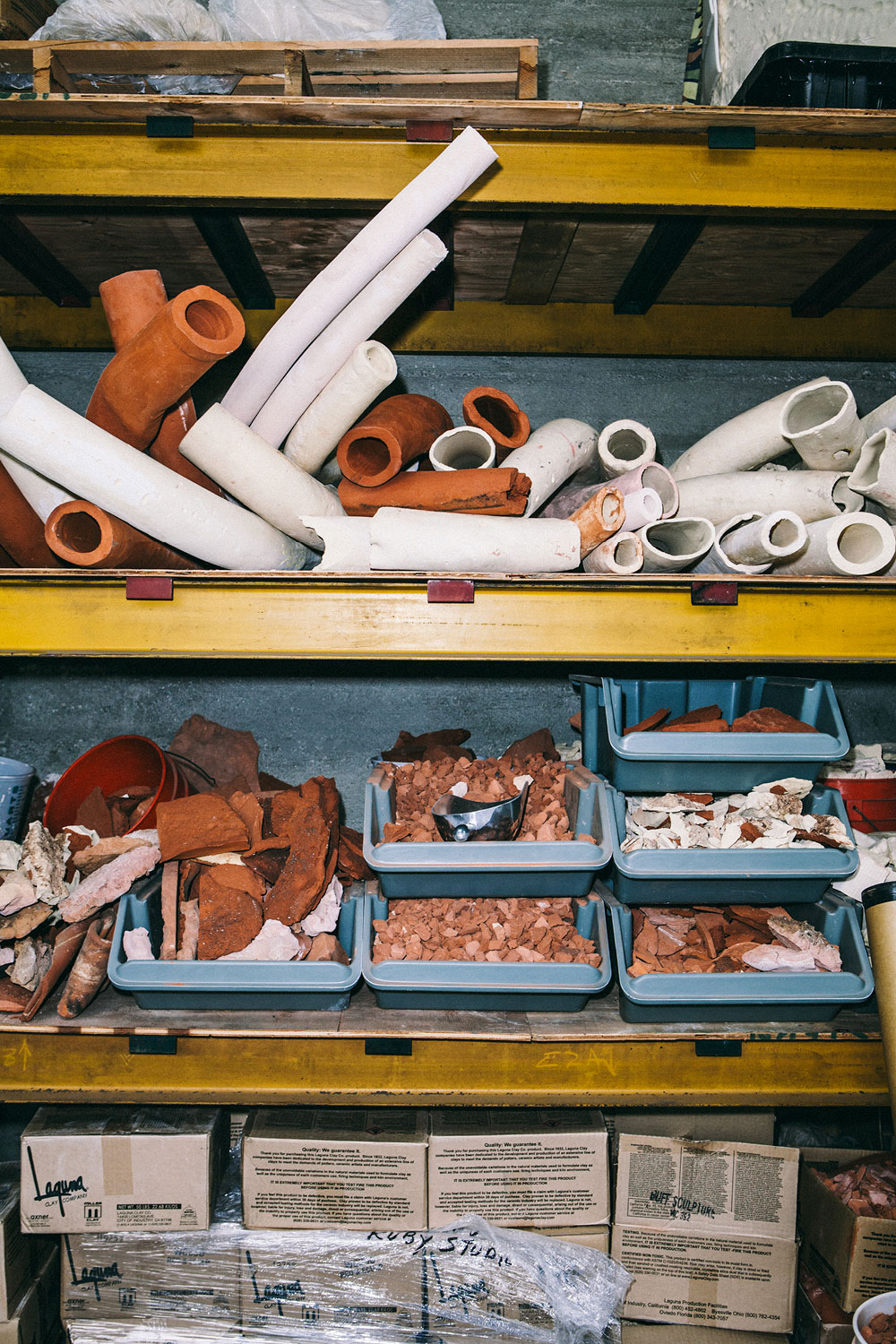
In the studio.
…
In 2009, he opened his first studio here, a 16,000-square-foot indoor-outdoor structure that became a media exemplar by suggesting that young artists were making it big in L.A. Testimony to the gritty, seemingly post-human landscape of Vernon, which so poetically frames his art, is the fact that one day a tractor-trailer careened through the wall of the building, causing no injuries—except to six paintings cumulatively worth millions.
After three years of permitting and construction, Ruby moved into his present studio in the fall of 2015. At 120,000 square feet and spread across four acres, the complex is a monumental expression of the artist’s predilection for extremes. By contrast, the man himself, blue-eyed and stringy-haired, comes across as neighborly, at times anxious, and perhaps not surprisingly a bit folksy—he was born in Germany on a U.S. military base to a Dutch mother and an American father, and reared in rural Pennsylvania. “We moved to the States shortly after I was born,” he says. “By the time I was 8, we were living on this big farm around an Amish community.” (Simons hails from near where Ruby’s mother’s family lived in the Netherlands, a coincidence they discovered early on in their friendship.)

An artwork in Ruby’s studio.
…

Scene from the studio.
…
Ruby arrived in L.A. as a transplant from the Midwest 15 years ago, after picking up an undergraduate degree at the School of the Art Institute of Chicago. He enrolled at the Art Center College of Design in Pasadena, a sleepy suburb 20 minutes northeast of Silver Lake. He would become the teaching assistant of the late Mike Kelley, who, among the pantheon of great 20th-century California artists, is known for his multidisciplinary practice and for inventing his own formal language inspired by tropes of modern Americana. Ruby’s time with Kelley proved formative. The two became friends, though they often disagreed on their interests and strategies as artists.
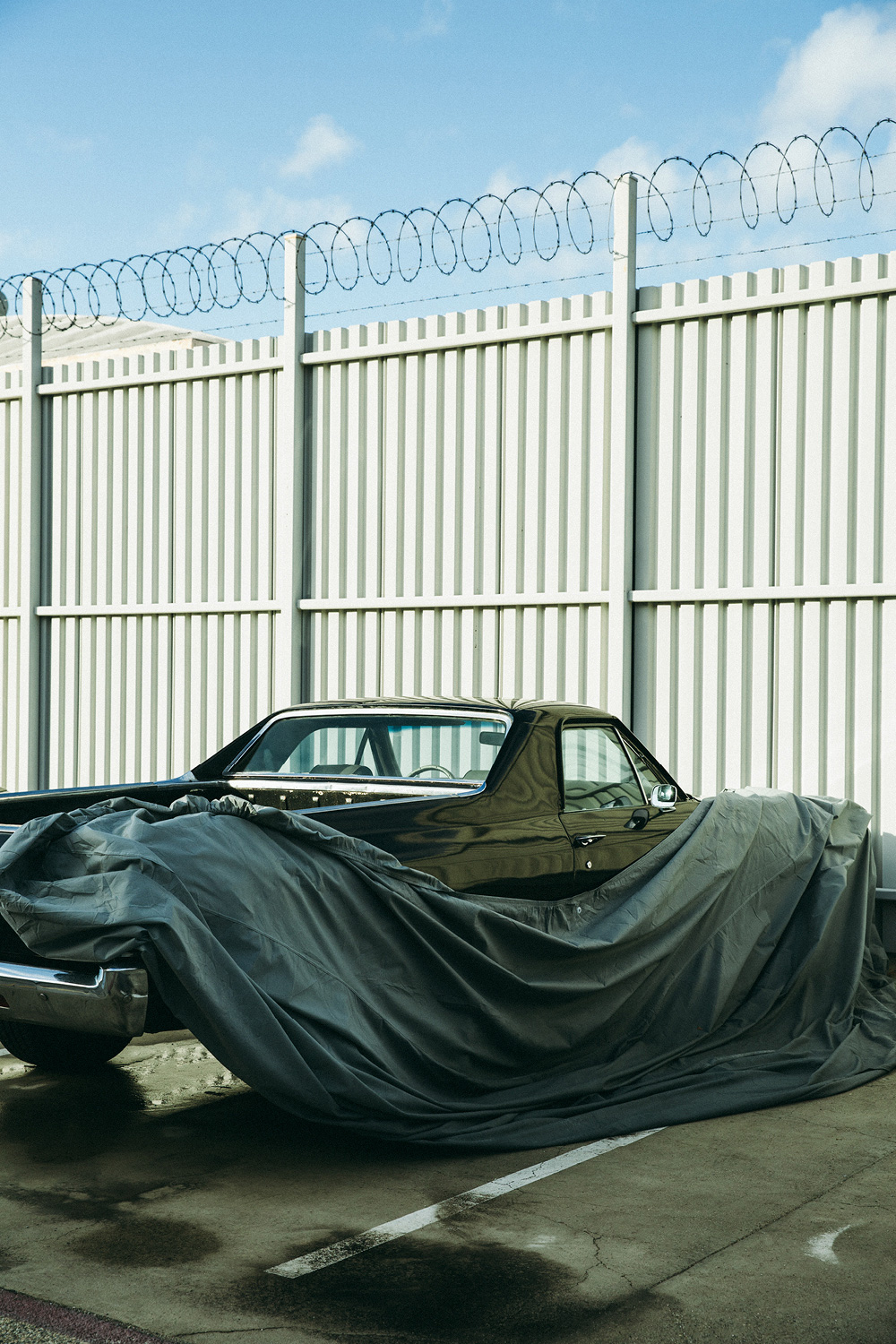
Outside Ruby’s studio.
…
Ruby’s ceramic basins—like the ones that initially captured Simons’s attention—reflect his omnivorous diet of forms. Timed with the Calvin Klein fall/winter 2017 show and brand relaunch, Gagosian Gallery will open an exhibition of such works, as well as other ceramic sculptures and paintings, at its location on New York’s Upper East Side, on view from March 1 to April 15. For Ruby, the show marks a return to the medium: though three basins were included in the Whitney Biennial in 2014, he hasn’t had a gallery show dedicated to ceramics in nearly 10 years. The works are as much about the artist looking back as looking forward. “I can use my own history and older body of work as this kind of archeological legacy,” he says, “to pull out these elements I was really happy with in the past, reassess and reinvent them into a potential future dig site.” The pieces are beguiling not only for their visceral rawness, but also for the way they coalesce elements of so many media. They draw on sculpture, of course, but they also employ painterly glazes and contain performative traces of shattered and reintegrated shards of clay. At the Whitney, they were deemed standouts by critics who, typically suspicious of Ruby’s commercial success, have otherwise often withheld such praises.
When it comes to preoccupations about “the market,” Ruby has little patience. Likewise, he has a disregard for zoomed-out conversations about art versus fashion. “I think that there’s actually a real parallel to the art world and to the fashion world, but I have no interest in it,” he says. “I just like the idea of creating something that people wear.” In his factory of ideas and in his artful threads, Ruby indeed lives in his work, a world unto itself without borders.
